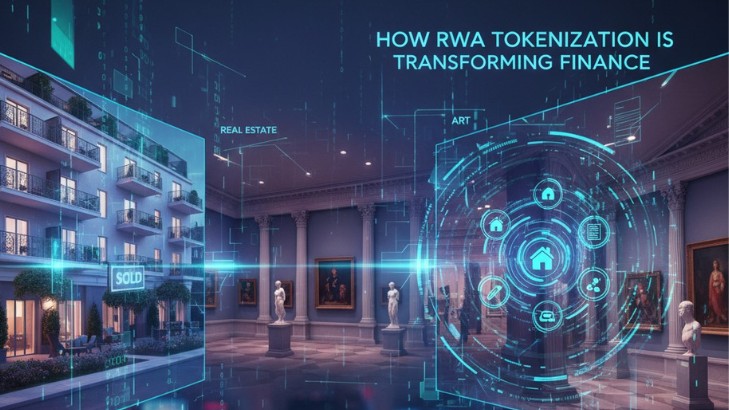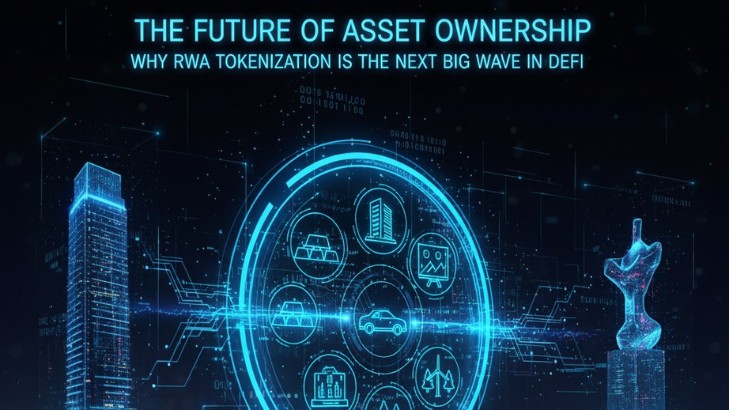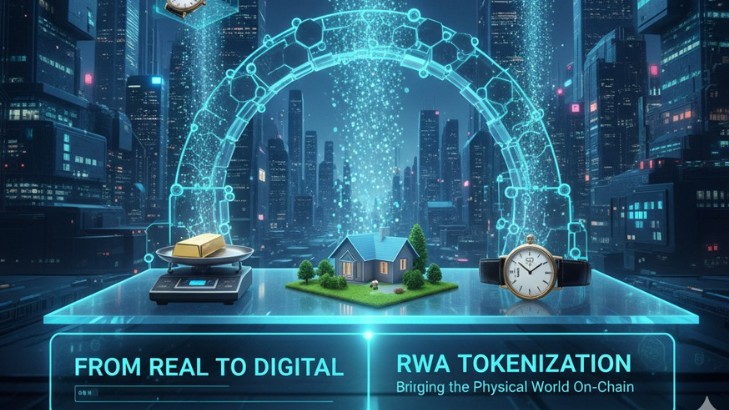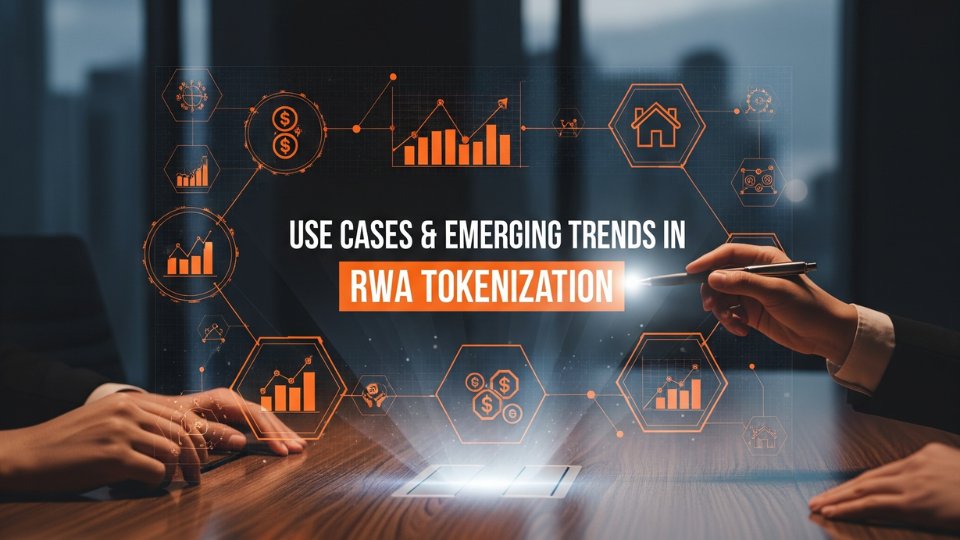How RWA Tokenization Is Revolutionizing Finance: From Real Estate to Art
October 7, 2025



The world of finance has always revolved around one core idea: representing and transferring value. From the earliest days of bartering to the introduction of coins, paper money, and modern digital banking, every financial innovation has aimed to make value exchange faster, safer, and more inclusive. Now, in the blockchain era, another revolutionary idea is emerging — Real-World Asset (RWA) tokenization.
RWA tokenization refers to the process of converting physical or traditional financial assets into digital tokens that exist on a blockchain. These tokens represent ownership or rights to the underlying asset — be it real estate, commodities, art, or debt instruments — and can be traded or utilized in decentralized financial ecosystems. This transformation isn’t just a technological novelty; it’s a redefinition of how finance itself operates.
As global institutions, investors, and regulators begin to embrace this paradigm, tokenization is rapidly transitioning from experimental pilot projects to a new infrastructure for capital markets. By bringing tangible assets like buildings and artworks “on-chain,” tokenization is reshaping liquidity, accessibility, and efficiency across multiple sectors of finance.
Understanding Real-World Asset (RWA) Tokenization
The Core Concept
At its core, tokenization is the process of converting a real-world asset — such as real estate, art, bonds, commodities, or even intellectual property — into a digital token that exists on a blockchain. Each of these tokens represents a specific share, right, or claim to the underlying asset. In simple terms, tokenization bridges the tangible and digital worlds by turning something physical or traditionally paper-based into a blockchain-based representation that can be easily stored, transferred, and verified.
For instance, imagine a commercial property valued at $1 million. Instead of requiring a single buyer to purchase the entire property, the owner could divide it into 10,000 digital tokens, each representing 0.01% ownership. These tokens could then be sold to multiple investors, enabling fractional ownership — where each participant holds a verifiable, traceable, and tradeable piece of that asset.
Because these tokens exist on a blockchain ledger, every transaction — from the initial issuance to later resales — is recorded transparently and immutably. This ensures clear proof of ownership, eliminates the risk of double-spending or record tampering, and drastically reduces the need for intermediaries. Beyond simple ownership, tokenized assets can also be used as collateral, integrated into decentralized finance (DeFi) applications, or even programmed with smart contracts to automate actions like rent distribution, dividend payouts, or profit sharing.
In essence, tokenization fuses the trust and regulation of traditional finance with the efficiency, programmability, and transparency of decentralized systems. It represents a powerful new paradigm where value can move freely and securely across digital networks — a step toward a more inclusive and interconnected global financial system.
Legal and Technical Foundations
Behind every successful Real-World Asset (RWA) tokenization project lies a carefully designed web of legal and technical frameworks that bridge digital representation with real-world enforceability. Tokenization is not merely a matter of putting an asset on a blockchain; it is about ensuring that what exists digitally has legal standing and protection in the physical world.
From a legal perspective, the critical question is: Does owning a token truly mean owning the underlying asset? To guarantee this, clear structures must be established that define and protect investors’ rights. Most commonly, this is achieved through Special Purpose Vehicles (SPVs) or trusts — legal entities that hold the asset (such as a building, artwork, or debt instrument) and issue digital tokens representing ownership stakes or economic participation. These entities serve as the legal bridge between the blockchain token and the asset itself, ensuring that token holders can exercise enforceable rights, such as receiving rental income, dividends, or proceeds from the sale of the asset.
On the technical side, the foundation rests on smart contracts — self-executing pieces of code that automate key business processes like dividend distribution, voting rights, buybacks, or ownership transfers. These smart contracts run on the blockchain, providing transparency, immutability, and autonomous execution without the need for intermediaries. Together with secure data feeds (oracles) that update real-world information on-chain, they ensure that tokenized assets behave predictably and consistently within digital ecosystems.
Ultimately, it is this fusion of legal enforceability and technical precision that gives RWA tokenization its strength. Legal structures provide the trust and legitimacy needed for real-world recognition, while blockchain-based automation delivers efficiency, transparency, and programmability — the core ingredients for scaling tokenized ownership in the global economy.
The Transformation of Accessibility
Breaking Down Barriers
Traditionally, access to high-value assets such as real estate, fine art, private equity, or luxury collectibles has been limited to a small circle of wealthy individuals and large institutions. The reasons were clear: high capital requirements, complex legal and administrative processes, and slow settlement mechanisms made it nearly impossible for everyday investors to participate. Ownership of premium assets often required millions in upfront capital, lengthy due diligence, and layers of intermediaries — effectively shutting out smaller investors.
Tokenization changes this dynamic by introducing fractional ownership, allowing assets that were once indivisible to be divided into smaller, more affordable digital shares. For example, a $10 million property can be split into 100,000 tokens, or a $5 million Picasso painting can be represented by 50,000 tokens, each symbolizing a verifiable ownership fraction. Investors can then buy and trade these fractions with ease, gaining access to asset classes that were previously beyond reach.
This shift represents more than just a technical innovation — it’s a democratization of finance. By lowering barriers to entry, tokenization enables participation from a broader, more diverse investor base across borders. It empowers retail investors, small funds, and even communities to diversify their portfolios and tap into the same opportunities once reserved for elites.
Moreover, the blockchain infrastructure behind these tokenized assets ensures transparency, traceability, and speed, making investment processes more efficient and inclusive. In essence, tokenization is not just transforming how assets are owned and traded — it’s reshaping who gets to own them, expanding financial inclusion on a global scale.
Global Participation and 24/7 Markets
One of the most powerful advantages of Real-World Asset (RWA) tokenization lies in its ability to enable global participation. Traditionally, investing across borders has been cumbersome — involving layers of intermediaries, currency conversions, documentation, and jurisdictional restrictions. Tokenization changes this by leveraging blockchain networks, which are inherently borderless and accessible to anyone with an internet connection and regulatory clearance.
In this new model, an investor in Asia can seamlessly purchase fractional ownership of a real estate property in Europe or a renewable energy project in North America — all within minutes and without navigating the slow, paper-heavy processes of traditional finance. As long as KYC (Know Your Customer) and AML (Anti-Money Laundering) requirements are met, participants can invest, trade, and transfer ownership securely from anywhere in the world.
Equally transformative is the 24/7 market accessibility that blockchain provides. Unlike conventional exchanges bound by business hours and local time zones, tokenized asset marketplaces never close. Trading can occur continuously, allowing investors to respond instantly to market developments, liquidity needs, or new opportunities. This around-the-clock activity not only improves market efficiency but also enhances liquidity — since buyers and sellers from different regions can interact in real time without waiting for markets to “open.”
Together, global accessibility and continuous trading form the backbone of a truly borderless financial ecosystem. Tokenization doesn’t just make markets more efficient; it makes them more inclusive, interconnected, and dynamic, reflecting the realities of a digital-first global economy.
Liquidity: Turning Illiquid Assets Into Tradable Ones
The Liquidity Problem in Traditional Finance
One of the most persistent challenges in traditional finance is illiquidity — the difficulty of quickly converting valuable assets into cash without significant loss of value. Assets such as real estate, fine art, private equity stakes, or infrastructure projects often represent immense wealth on paper, yet remain locked up for long periods because they cannot be easily sold or traded.
In conventional systems, selling such assets is a slow and complex process. A property owner, for instance, must find a qualified buyer, negotiate terms, handle legal documentation, and wait for financial clearances — a cycle that can take weeks or even months. The same applies to art collectors or private investors seeking to exit positions; transactions are often private, illiquid, and dependent on a narrow pool of buyers. This not only limits flexibility but also reduces overall market efficiency, as capital becomes trapped in assets that cannot be quickly mobilized.
Furthermore, high transaction costs, intermediary fees, and jurisdictional barriers make the process even more cumbersome. For institutional portfolios, this means long holding periods and limited agility in reallocating funds. For smaller investors, it often means exclusion from these asset classes altogether, since participation typically requires a long-term commitment of substantial capital.
This fundamental lack of liquidity has long been seen as an inevitable cost of investing in the real economy — but tokenization challenges that assumption. By enabling fractional ownership and digital transferability, it introduces a mechanism for turning traditionally illiquid assets into tradeable, dynamic financial instruments that can move more freely within global markets.
Liquidity Through Tokenization
Tokenization changes this dynamic entirely. When an asset is fractionalized and represented by tokens, those tokens can be traded on secondary markets — enabling liquidity that traditional systems could never achieve. If you own tokens representing a share in a property or artwork, you can sell them instantly to another investor on a digital exchange.
This doesn’t just benefit investors who want flexibility; it also benefits asset owners and developers, who can unlock capital faster without having to sell entire properties or assets. Over time, as regulated secondary markets for RWAs mature, liquidity will continue to improve, making tokenized assets an even more attractive investment class.
The Power of Programmability
Smart Contracts and Automation
Traditional asset management involves a web of manual processes — accountants distributing dividends, brokers transferring ownership, and custodians managing ledgers. With tokenization, all of this can be automated through smart contracts. These programmable contracts automatically execute actions based on predefined conditions.
For example, a tokenized apartment building can automatically distribute monthly rental income to token holders. Similarly, if the building is sold, smart contracts can ensure that proceeds are proportionally distributed instantly. This automation reduces administrative costs, minimizes errors, and accelerates settlement times.
Composability: Building on Top of Tokenized Assets
Another revolutionary feature of blockchain-based finance is composability — the ability for different digital assets and applications to interact seamlessly. Tokenized RWAs can be integrated into decentralized finance (DeFi) protocols for lending, collateralization, or yield generation.
Imagine using a token representing a fraction of a real estate property as collateral to take out a crypto loan or combining different types of tokenized assets to create new financial products. This interoperability creates endless opportunities for innovation.
The Challenges of Tokenization
Regulatory Uncertainty
Despite the excitement, tokenization faces significant hurdles — and the biggest is regulation. Laws governing securities, property rights, and digital assets vary dramatically across countries. For tokenization to thrive, jurisdictions need to create clear legal frameworks that define how tokens map to ownership rights and what happens in disputes.
Some governments are moving faster than others. Jurisdictions like Switzerland, Singapore, and the UAE have already introduced regulatory sandboxes and digital asset laws. Meanwhile, others are still catching up, causing uncertainty for global investors and issuers.
Custody and Asset Verification
When the underlying asset is physical — like gold, art, or real estate — it must be securely stored and properly verified. Custodians play a critical role here. They ensure that the asset actually exists, is insured, and remains safe. Without trusted custodians and transparent audits, tokenized assets could lose credibility.
This is why professional custodial arrangements and insurance are indispensable in the tokenization ecosystem. The token is only as valuable as the trust investors have that it truly represents a tangible, enforceable claim.
Valuation and Oracles
Valuing tokenized assets also presents challenges. While government bonds or commodities have transparent prices, assets like art or boutique real estate rely on subjective appraisals. Moreover, on-chain smart contracts require real-world data inputs — known as oracles — to execute correctly. If oracles feed inaccurate data, automated processes can fail, leading to financial losses.
Robust oracle systems and transparent valuation mechanisms are therefore essential for the long-term success of RWA tokenization.
Tokenization in Real Estate
The Perfect Use Case
Real estate has emerged as the leading sector for tokenization — and for good reason. It’s a trillion-dollar asset class that suffers from extreme illiquidity and high entry barriers. Tokenization offers solutions to both.
Developers and asset managers can tokenize individual properties, rental income streams, or even future construction projects. Investors, in turn, can buy tokens representing small portions of these assets, gaining exposure to real estate markets without needing to purchase entire properties.
Benefits for Developers and Investors
For developers, tokenization opens up new fundraising methods. Instead of relying solely on banks or institutional investors, they can raise capital directly from a global investor base through blockchain platforms. This democratizes access to capital and speeds up financing cycles.
For investors, the benefits are equally clear — lower minimum investments, faster transactions, transparent ownership records, and the ability to trade or use real estate tokens as collateral. Over time, as secondary markets deepen, real estate tokenization could make property as liquid and tradeable as stocks.
Tokenization in Art and Collectibles
From Exclusive to Inclusive
The art market, historically dominated by elite collectors, is undergoing a quiet revolution through tokenization. By fractionalizing ownership, tokenization allows everyday investors to hold shares in iconic artworks worth millions of dollars. This opens up an entirely new asset class to the broader public.
Custody, Appraisal, and Regulation
In this domain, custody and appraisal are particularly crucial. Tokenization platforms partner with art galleries, insurers, and auditors to authenticate and store artworks. Tokens issued represent legally recognized shares in the asset, not just digital copies or NFTs with no real-world claim.
This distinction is vital. Investors aren’t just speculating on digital images — they’re investing in tangible, physical art with verifiable value and provenance. As more institutions embrace these standards, art tokenization is poised to become one of the most exciting growth areas in finance.
Tokenization of Financial Instruments: Bonds and Treasuries
The Institutional Angle
While real estate and art capture the imagination, tokenization of traditional financial instruments like bonds, money-market funds, and treasuries is gaining the most institutional traction. These assets are familiar, standardized, and heavily regulated — making them easier to tokenize at scale.
In fact, several asset management firms have already launched tokenized treasury funds on blockchain networks. These instruments combine the safety and yield of government securities with the efficiency and composability of blockchain. Investors can buy, hold, and transfer these digital tokens instantly, with full transparency.
On-Chain Liquidity and Efficiency
Tokenized treasuries also serve as excellent on-chain collateral. DeFi protocols, stablecoins, and financial platforms can integrate these tokens to back loans, payments, and synthetic assets. As on-chain liquidity grows, tokenized treasuries may become the backbone of digital financial infrastructure — much like traditional bonds underpin today’s global economy.
Infrastructure, Standards, and Security
Building the Plumbing for Tokenization
Behind the scenes, tokenization depends on robust infrastructure — legal, technical, and operational. This includes standardized token formats (such as ERC-3643 for permissioned tokens), identity verification frameworks, KYC/AML compliance systems, and secure custody models.
These foundational components ensure that tokenized markets are safe, compliant, and interoperable. As infrastructure providers refine these standards, tokenization will scale more rapidly and seamlessly across asset classes.
Risk Management and Insurance
Tokenization introduces both traditional financial risks and new technological ones. Smart contract bugs, oracle failures, or custody breaches can all cause significant losses. To mitigate this, third-party audits, multisignature custody setups, and insurance mechanisms are becoming standard practice. This risk management layer is what will make tokenized finance resilient enough for mainstream adoption.
The Broader Economic and Social Impact
Financial Inclusion and Democratization
Perhaps the most transformative aspect of tokenization is its potential for inclusion. By lowering entry barriers and fractionalizing ownership, tokenization allows millions of small investors to participate in global markets. It could redefine wealth distribution and empower individuals in emerging economies to invest in previously inaccessible assets.
Challenges of Oversight and Fairness
However, increased accessibility also introduces challenges. Regulators will need to ensure that these new markets remain transparent, fair, and free from manipulation. Education will play a crucial role in helping retail investors understand what they’re buying and how tokenized assets differ from traditional securities.
The Future of Tokenization
Hybrid Products and Composability
As tokenization evolves, new hybrid financial products will emerge. Imagine tokenized portfolios that blend real estate, art, and treasury yields — all rebalanced automatically through smart contracts. Or community-driven projects where token holders collectively fund and own infrastructure like solar farms or affordable housing.
The composability of blockchain allows these assets to interact across ecosystems, unlocking innovation that’s simply not possible in traditional finance.
Global Adoption and Regulation
The next decade will likely bring clearer regulations, standardized legal frameworks, and broader institutional participation. Governments that embrace tokenization early will attract capital and innovation. Those that resist may find themselves left behind as financial systems become more open, efficient, and borderless.
Conclusion
Real-World Asset (RWA) tokenization marks a defining moment in the evolution of global finance — the convergence of the tangible and the digital, where centuries-old asset classes meet the speed, transparency, and programmability of blockchain technology. By bringing physical and financial assets such as real estate, art, commodities, and bonds onto the blockchain, tokenization is fundamentally transforming how value is stored, transferred, and managed.
The potential benefits are profound. Tokenization introduces liquidity to asset classes that have historically been illiquid, allowing fractional trading and faster settlement. It democratizes access to investment opportunities that were once the exclusive domain of institutions and high-net-worth individuals. It provides transparent, immutable ownership records, reducing disputes and fraud. And it embeds programmability into financial systems, enabling automated functions like income distribution, compliance enforcement, and governance through smart contracts.
However, realizing this promise requires careful execution and collaboration across multiple domains. The technology must be supported by clear legal frameworks, secure custodial systems, reliable valuation and oracle infrastructures, and comprehensive investor education. Without these foundations, tokenized assets risk losing their credibility and connection to the real world they represent.
As blockchain technology matures and regulators around the world provide clearer guidance, tokenization is poised to transition from an emerging innovation to a core layer of global financial infrastructure. It represents not merely an upgrade to existing systems, but a reimagining of ownership and participation in the global economy.
The boundary between the real and digital worlds is rapidly dissolving. Through tokenization, these two domains are becoming one unified financial ecosystem — more accessible, efficient, and equitable than ever before. The next era of finance will not just be digital; it will be tokenized.




.avif)



